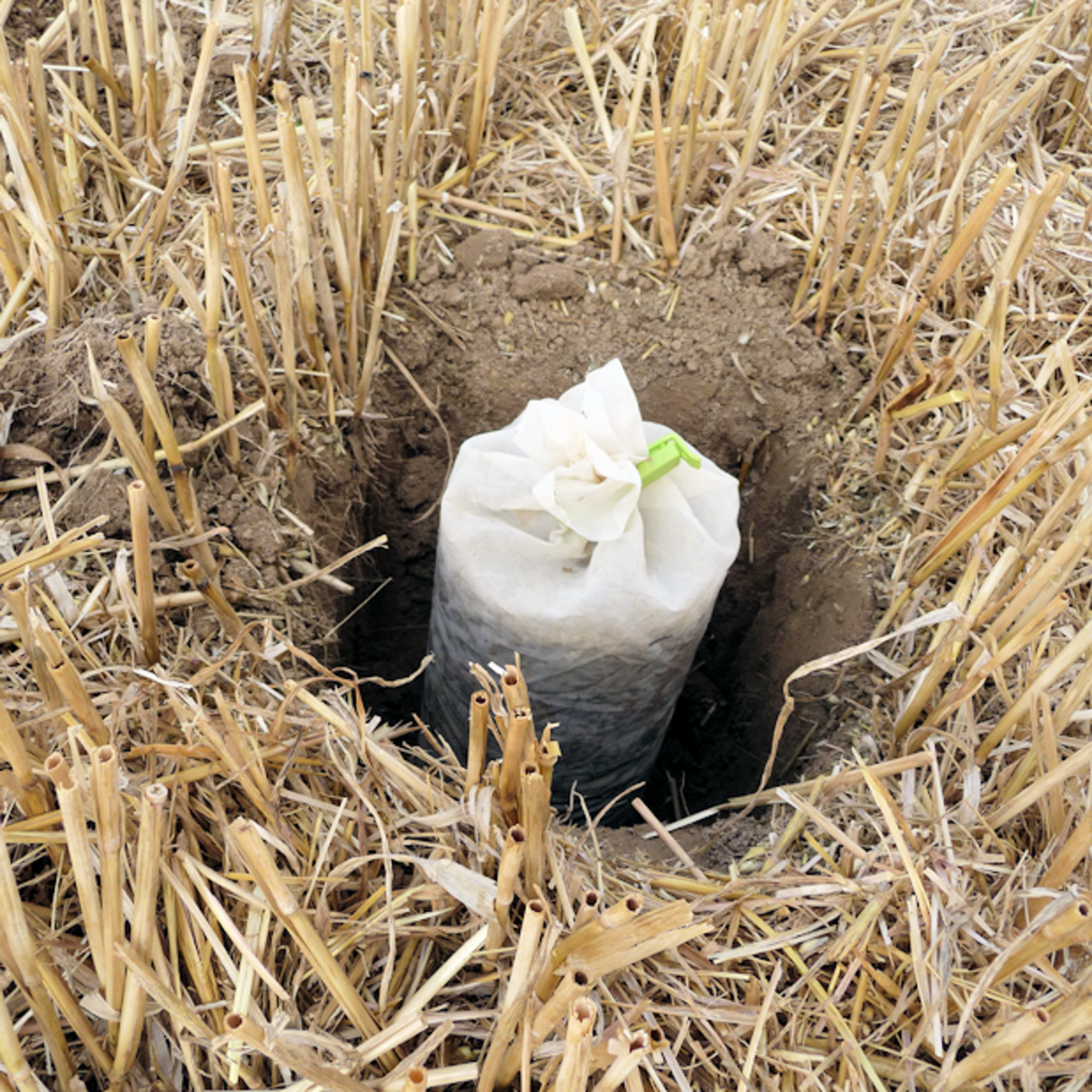Project
Biological control of phytopathogenic fungi

Biological control of phytopathogenic fungi by soil fauna
Agricultural production of food, feed and renewable resources requires a healthy soil. However, soil-borne pathogens may endanger quality and quantity of the crop yield. The soil biodiversity pool delivers ecosystem services, which promote the repression of pathogenic soil fungi and the degradation of mycotoxins.
Background and Objective
Conservation tillage as a measure of agricultural soil protection promotes soil biodiversity and soil biological activity by the provision of remaining crop residues on and near the soil surface. However, this kind of residue management may increase the infection risk for cereal crops with soil-borne phytopathogenic fungi, which produce harmful mycotoxins. Fungi species of the genus Fusarium with its most frequent toxin deoxynivalenol are economically very important. In this context we follow the hypothesis: Fungivorous soil fauna mitigate the risk originating from crop residues on the soil surface. We identify and assess ecosystem services of soil fauna to answer the following questions:
(i) How do different soil fauna groups contribute to Fusarium repression and deoxynivalenol degradation?
(ii) How relevant is the interaction of different soil fauna groups in this context?
(iii) Does soil texture matter for these processes?
Approach
Field and laboratory experiments are conducted. The experiments consider different species of earthworms and fungivorous collembolans and soil nematodes. We use micro- and mesocosms, which are set up with soil, infected straw and defined densities of soil fauna in varying combinations. Compared with control units, the contents of Fusarium proteins and deoxynivalenol are quantified in soil and remaining straw for specified experimental dates.
Results
So far, results were obtained for different earthworm species, collembolans and nematodes in field and laboratory studies. Earthworms play an important role in the control of the phytopathogenic fungi Fusarium culmorum surviving on plant residues. Furthermore, they accelerate the degradation of its mycotoxin deoxynivalenol. Compared to secondary decomposers, earthworm species belonging to primary decomposers are the drivers of these processes. Interacting collembolans and nematodes have a high impact on these processes. Soil texture is an important factor, which controls the provision of ecosystem services by soil fauna.
Thünen-Contact

Involved Thünen-Partners
Involved external Thünen-Partners
- Julius Kühn-Institut - Bundesforschungsinstitut für Kulturpflanzen (JKI)
(Quedlinburg, Braunschweig, Groß Lüsewitz, Kleinmachnow, Deutschland)
Funding Body
-
German Federal Environmental Foundation (DBU)
(national, öffentlich)
Duration
5.2009 - 6.2015
More Information
Project status:
finished
Publications
- 0
Jacobs A, Schrader S, Babin D, Beylich A, Brunotte J, Dauber J, Emmerling C, Engell I, Flessa H, Hallmann J, Hommel B, Klages S, Lehmhus J, Meyer M, Meyer-Wolfarth F, Potthoff M, Runge T, Schulz-Kesting K, Tebbe CC, Capelle C van, et al (2022) Lebendige Böden - fruchtbare Böden. Bonn: Bundesanstalt für Landwirtschaft und Ernährung, 48 p
- 1
Schrader S, Capelle C van, Meyer-Wolfarth F (2020) Regenwürmer als Partner bei der Bodennutzung : Die Servicekräfte des Bodens. Biol Unserer Zeit 50(3):192-198, DOI:10.1002/biuz. 202010706
- 2
Meyer-Wolfarth F, Schrader S, Oldenburg E, Weinert J, Brunotte J (2017) Biocontrol of the toxigenic plant pathogen Fusarium culmorum by soil fauna in an agroecosystem. Mycotoxin Res 33(3):237-244, DOI:10.1007/s12550-017-0282-1
- 3
Meyer-Wolfarth F, Schrader S, Oldenburg E, Weinert J, Brunotte J (2017) Collembolans and soil nematodes as biological regulators of the plant pathogen Fusarium culmorum. J Plant Dis Protect 124(5):493-498, DOI:10.1007/s41348-017-0111-y
- 4
Schrader S (2016) Bodeninvertebraten sind entscheidende ökologische Leistungsträger. Agrobiodiversität 39:67-80
- 5
Wolfarth F, Schrader S, Oldenburg E, Brunotte J (2016) Mycotoxin contamination and its regulation by the earthworm species Lumbricus terrestris in presence of other soil fauna in an agroecosystem. Plant Soil 402(1-2):331-342, DOI:10.1007/s11104-015-2772-2
- 6
Wolfarth F, Wedekind S, Schrader S, Oldenburg E, Brunotte J (2015) Regulation of the mycotoxin deoxynivalenol by Folsomia candida (Collembola) and Aphelenchoides saprophilus (Nematoda) in an on-farm experiment. Pedobiologia 58(1):41-47, DOI:10.1016/j.pedobi.2015.01.003
- 7
Schrader S, Wolfarth F, Oldenburg E, Brunotte J (2014) Förderung der Bodengesundheit – Bodentiere dezimieren Schadpilze und ihre Toxine. Forschungsreport Ernähr Landwirtsch Verbrauchersch(1):4-7
- 8
Schrader S, Wolfarth F, Oldenburg E (2013) Biological control of soil-borne phytopathogenic fungi and their mycotoxins by soil fauna – A review. Bull Univ Agric Sci Vet Med Cluj Napoca Agric 70(2):291-298
- 9
Wolfarth F, Schrader S, Oldenburg E, Weinert J (2013) Nematode-collembolan-interaction promotes the degradation of Fusarium biomass and deoxynivalenol according to soil texture. Soil Biol Biochem 57:903-910, DOI:10.1016/j.soilbio.2012.11.001
- 10
Wolfarth F, Schrader S, Oldenburg E, Weinert J (2011) Contribution of the endogeic earthworm species Aporrectodea caliginosa to the degradation of deoxynivalenol and Fusarium biomass in wheat straw. Mycotoxin Res 27(3):215-220, doi:10.1007/s12550-011-0098-3
- 11
Wolfarth F, Schrader S, Oldenburg E, Weinert J, Brunotte J (2011) Earthworms promote the reduction of Fusarium biomass and deoxynivalenol content in wheat straw under field conditions. Soil Biol Biochem 43(9):1858-1865, DOI:10.1016/j.soilbio.2011.05.002
- 12
Oldenburg E, Kramer S, Schrader S, Weinert J (2008) Impact of the earthworm Lumbricus terrestris on the degradation of Fusarium-infected and deoxynivalenol-contaminated wheat straw. Soil Biol Biochem 40(12):3049-3053, DOI:10.1016/j.soilbio.2008.09.004

![[Translate to English:] Logo des Bundesministerium für Ernährung und Landwirtschaft](/media/allgemein/logos/BMEL_Logo.svg)